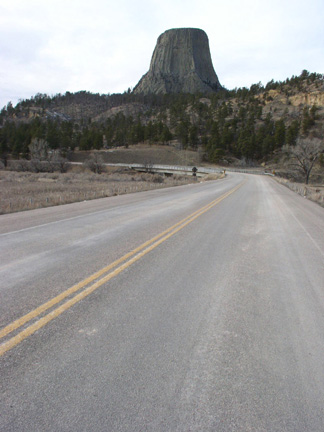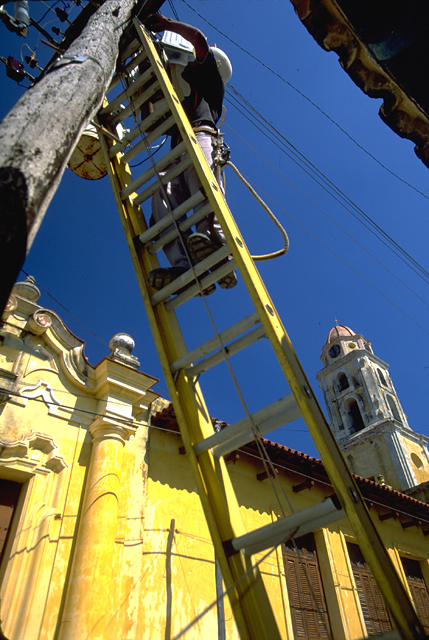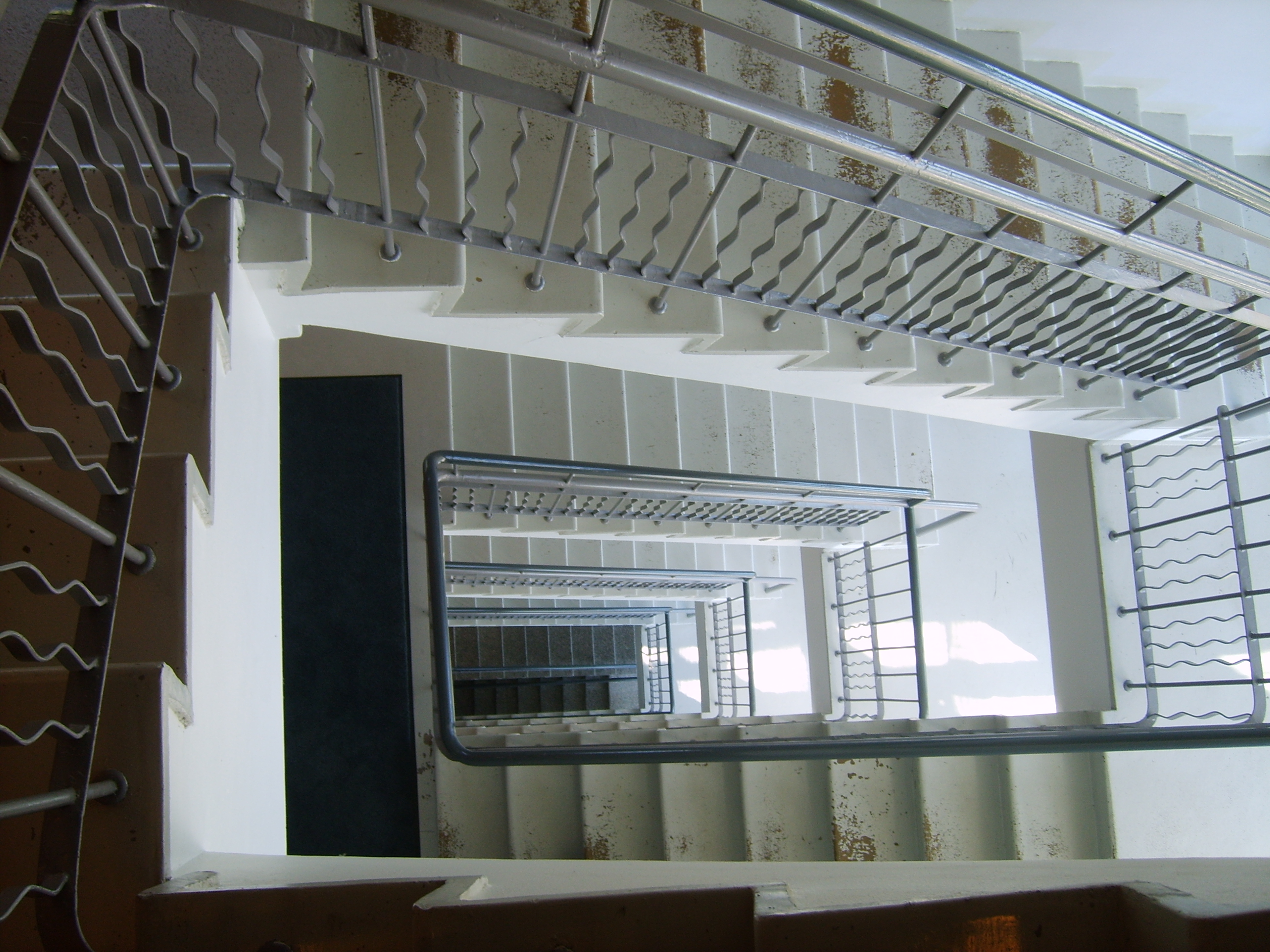|
Tower Ladder (Devils Tower National Monument)
The Ladder at Devils Tower was first constructed and used in 1893 by William Rogers and Willard Ripley to publicly ascend Devil's Tower. Two years later Roger's wife Linnie ascended the tower via the ladder, one of a total of about 215 who have used the ladder. The last use was by Babe "The Human Fly" White in 1927. The present tower ladder consists of a series of wooden stakes connected on the outside by vertical wood planks. One end of each stake is driven sideways into a rock crevice, vertically ascending the southeast side of the tower. Attached with nails and/or baling wire to the other end of the stakes are 12-inch lengths of 1 x 4 - inch lumber. The ladder ascends from about 100 feet above the ground to the summit, and is about 170 feet long. Because of its small scale in comparison to the tower, it is very difficult to see in modern photographs, and visitors to the tower usually must view it through a telescope. The lowest 100 feet were removed in the 1930s as a safety mea ... [...More Info...] [...Related Items...] OR: [Wikipedia] [Google] [Baidu] |
Devils Tower, Wyoming
Devils Tower (also known as Bear Lodge Butte) is a butte, possibly laccolithic, composed of igneous rock in the Bear Lodge Ranger District of the Black Hills, near Hulett and Sundance in Crook County, northeastern Wyoming, above the Belle Fourche River. It rises 1,267 feet (386 m) above the Belle Fourche River, standing 867 feet (265 m) from summit to base. The summit is 5,112 feet (1,559 m) above sea level. Devils Tower was the first United States national monument, established on September 24, 1906 by President Theodore Roosevelt. The monument's boundary encloses an area of . Name Native American names for the monolith include "Bear's House" or "Bear's Lodge" (or "Bear's Tipi", "Home of the Bear", "Bear's Lair"); Cheyenne, lkt, Matȟó Thípila, cro, Daxpitcheeaasáao ("Home of Bears"), "Aloft on a Rock" (Kiowa), "Tree Rock", "Great Gray Horn", and "Brown Buffalo Horn" ( lkt, Ptehé Ǧí). The name "Devil's Tower" originated in 1875 during an expedition led by Colonel ... [...More Info...] [...Related Items...] OR: [Wikipedia] [Google] [Baidu] |
Devils Tower National Monument
Devils Tower (also known as Bear Lodge Butte) is a butte, possibly laccolithic, composed of igneous rock in the Bear Lodge Ranger District of the Black Hills, near Hulett and Sundance in Crook County, northeastern Wyoming, above the Belle Fourche River. It rises 1,267 feet (386 m) above the Belle Fourche River, standing 867 feet (265 m) from summit to base. The summit is 5,112 feet (1,559 m) above sea level. Devils Tower was the first United States national monument, established on September 24, 1906 by President Theodore Roosevelt. The monument's boundary encloses an area of . Name Native American names for the monolith include "Bear's House" or "Bear's Lodge" (or "Bear's Tipi", "Home of the Bear", "Bear's Lair"); Cheyenne, lkt, Matȟó Thípila, cro, Daxpitcheeaasáao ("Home of Bears"), "Aloft on a Rock" (Kiowa), "Tree Rock", "Great Gray Horn", and "Brown Buffalo Horn" ( lkt, Ptehé Ǧí). The name "Devil's Tower" originated in 1875 during an expedition led by Colonel ... [...More Info...] [...Related Items...] OR: [Wikipedia] [Google] [Baidu] |
Entrance Road-Devils Tower National Monument
The Entrance Road at Devils Tower National Monument, officially known as Wyoming Highway 110, is a scenic road that provides the approach to the Devil's Tower eminence, affording planned views to arriving visitors. Route description The Wyoming Highway 110 designation is a short roadway that starts its at Wyoming Highway 24 and travels west to the Devils Tower National Monument Entrance. Mileposts along WYO 110 increase from east to west. The entrance road is a long, two-lane, asphalt paved road that spans the distance between the Entrance Station and the visitor parking area located just west of Devil's Tower. The road provides access to the monument's primary developed areas, such as headquarters and visitor center. History The road was originally constructed in 1917 with an eight percent grade and a ford at the Belle Fourche River. A bridge was built in 1928, and the road was extensively altered in the 1930s with labor from the Civilian Conservation Corps, improvin ... [...More Info...] [...Related Items...] OR: [Wikipedia] [Google] [Baidu] |
Entrance Station-Devils Tower National Monument
The Entrance Station at Devils Tower National Monument is a log cabin in the National Park Service Rustic style, built in 1941. The cabin is based on 1933 plans created by the National Park Service Landscape Division for a now-vanished caretaker's cabin at Aspenglen Campground in Rocky Mountain National Park, adapted by NPS architect Howard W. Baker of the Branch of Plans and Design for dual use as an entrance station and as a residence. It features a unique porch with rough-cut projecting log ends in a scooped pattern. The interior was renovated in 1999, replacing the living spaces with office space. See also * Entrance Road-Devils Tower National Monument *Old Headquarters Area Historic District The Old Headquarters Area at Devils Tower National Monument includes three structures and their surroundings, including the old headquarters building, the custodian's house, and the fire hose house. The buildings are all designed in the Nationa ... * Tower Ladder-Devils Tower Nation ... [...More Info...] [...Related Items...] OR: [Wikipedia] [Google] [Baidu] |
Old Headquarters Area Historic District
The Old Headquarters Area at Devils Tower National Monument includes three structures and their surroundings, including the old headquarters building, the custodian's house, and the fire hose house. The buildings are all designed in the National Park Service Rustic style. Funded as an Emergency Conservation Works project and built by the Civilian Conservation Corps in 1935, the old administration building was used as the monument's headquarters and museum until 1959. At that time, headquarters was relocated while the building continued its function as the park's primary visitor center. Today the main level of the building serves as the visitor center; the basement level has public restrooms, museum storage, interpreter's office, library, storage for search and rescue and first aid equipment and supplies, and a fuel oil furnace. The upper level, originally designed for use as a bedroom, is now used for storage and houses an evaporative cooler. The custodian's residence was desi ... [...More Info...] [...Related Items...] OR: [Wikipedia] [Google] [Baidu] |
National Register Of Historic Places In Devils Tower National Monument
National may refer to: Common uses * Nation or country ** Nationality – a ''national'' is a person who is subject to a nation, regardless of whether the person has full rights as a citizen Places in the United States * National, Maryland, census-designated place * National, Nevada, ghost town * National, Utah, ghost town * National, West Virginia, unincorporated community Commerce * National (brand), a brand name of electronic goods from Panasonic * National Benzole (or simply known as National), former petrol station chain in the UK, merged with BP * National Car Rental, an American rental car company * National Energy Systems, a former name of Eco Marine Power * National Entertainment Commission, a former name of the Media Rating Council * National Motor Vehicle Company, Indianapolis, Indiana, USA 1900-1924 * National Supermarkets, a defunct American grocery store chain * National String Instrument Corporation, a guitar company formed to manufacture the first resona ... [...More Info...] [...Related Items...] OR: [Wikipedia] [Google] [Baidu] |
Buildings And Structures In Crook County, Wyoming
A building, or edifice, is an enclosed structure with a roof and walls standing more or less permanently in one place, such as a house or factory (although there's also portable buildings). Buildings come in a variety of sizes, shapes, and functions, and have been adapted throughout history for a wide number of factors, from building materials available, to weather conditions, land prices, ground conditions, specific uses, prestige, and aesthetic reasons. To better understand the term ''building'' compare the list of nonbuilding structures. Buildings serve several societal needs – primarily as shelter from weather, security, living space, privacy, to store belongings, and to comfortably live and work. A building as a shelter represents a physical division of the human habitat (a place of comfort and safety) and the ''outside'' (a place that at times may be harsh and harmful). Ever since the first cave paintings, buildings have also become objects or canvasses of much artis ... [...More Info...] [...Related Items...] OR: [Wikipedia] [Google] [Baidu] |
Ladders
A ladder is a vertical or inclined set of rungs or steps used for climbing or descending. There are two types: rigid ladders that are self-supporting or that may be leaned against a vertical surface such as a wall, and rollable ladders, such as those made of rope or aluminium, that may be hung from the top. The vertical members of a rigid ladder are called stringers or rails (US) or stiles (UK). Rigid ladders are usually portable, but some types are permanently fixed to a structure, building, or equipment. They are commonly made of metal, wood, or fiberglass, but they have been known to be made of tough plastic. Historical usages Ladders are ancient tools and technology. A ladder is featured in a Mesolithic rock painting that is at least 10,000 years old, depicted in the Spider Caves in Valencia, Spain. The painting depicts two humans using a ladder to reach a wild honeybee nest to harvest honey. The ladder is depicted as long and flexible, possibly made out of some sort of g ... [...More Info...] [...Related Items...] OR: [Wikipedia] [Google] [Baidu] |
Stairways In The United States
Stairs are a structure designed to bridge a large vertical distance between lower and higher levels by dividing it into smaller vertical distances. This is achieved as a diagonal series of horizontal platforms called steps which enable passage to the other level by stepping from one to another step in turn. Steps are very typically rectangular. Stairs may be straight, round, or may consist of two or more straight pieces connected at angles. Types of stairs include staircases (also called stairways), ladders, and escalators. Some alternatives to stairs are elevators (also called lifts), stairlifts, inclined moving walkways, and ramps. A stairwell is a vertical shaft or opening that contains a staircase. A flight (of stairs) is an inclined part of a staircase consisting of steps (and their lateral supports if supports are separate from steps). Components and terms A ''stair'', or a ''stairstep'', is one step in a flight of stairs.R.E. Putnam and G.E. Carlson, ''Architectural an ... [...More Info...] [...Related Items...] OR: [Wikipedia] [Google] [Baidu] |
Stairways On The National Register Of Historic Places
Stairs are a structure designed to bridge a large vertical distance between lower and higher levels by dividing it into smaller vertical distances. This is achieved as a diagonal series of horizontal platforms called steps which enable passage to the other level by stepping from one to another step in turn. Steps are very typically rectangular. Stairs may be straight, round, or may consist of two or more straight pieces connected at angles. Types of stairs include staircases (also called stairways), ladders, and escalators. Some alternatives to stairs are elevators (also called lifts), stairlifts, inclined moving walkways, and ramps. A stairwell is a vertical shaft or opening that contains a staircase. A flight (of stairs) is an inclined part of a staircase consisting of steps (and their lateral supports if supports are separate from steps). Components and terms A ''stair'', or a ''stairstep'', is one step in a flight of stairs.R.E. Putnam and G.E. Carlson, ''Architectural a ... [...More Info...] [...Related Items...] OR: [Wikipedia] [Google] [Baidu] |
Transportation Buildings And Structures On The National Register Of Historic Places In Wyoming
Transport (in British English), or transportation (in American English), is the intentional movement of humans, animals, and goods from one location to another. Modes of transport include air, land (rail and road), water, cable, pipeline, and space. The field can be divided into infrastructure, vehicles, and operations. Transport enables human trade, which is essential for the development of civilizations. Transport infrastructure consists of both fixed installations, including roads, railways, airways, waterways, canals, and pipelines, and terminals such as airports, railway stations, bus stations, warehouses, trucking terminals, refueling depots (including fueling docks and fuel stations), and seaports. Terminals may be used both for interchange of passengers and cargo and for maintenance. Means of transport are any of the different kinds of transport facilities used to carry people or cargo. They may include vehicles, riding animals, and pack animals. Vehicles may inc ... [...More Info...] [...Related Items...] OR: [Wikipedia] [Google] [Baidu] |







